锂电池航空运输指南-英文
- 格式:pdf
- 大小:193.63 KB
- 文档页数:20
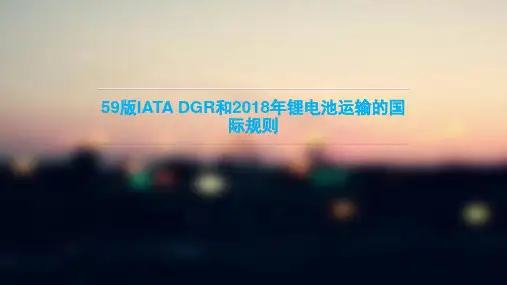
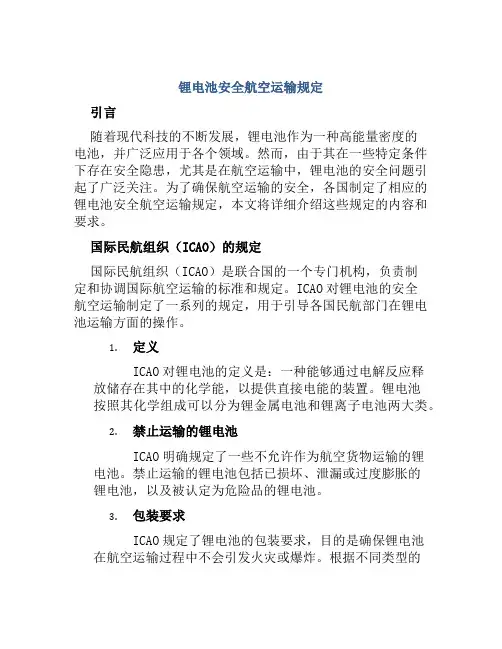
锂电池安全航空运输规定引言随着现代科技的不断发展,锂电池作为一种高能量密度的电池,并广泛应用于各个领域。
然而,由于其在一些特定条件下存在安全隐患,尤其是在航空运输中,锂电池的安全问题引起了广泛关注。
为了确保航空运输的安全,各国制定了相应的锂电池安全航空运输规定,本文将详细介绍这些规定的内容和要求。
国际民航组织(ICAO)的规定国际民航组织(ICAO)是联合国的一个专门机构,负责制定和协调国际航空运输的标准和规定。
ICAO对锂电池的安全航空运输制定了一系列的规定,用于引导各国民航部门在锂电池运输方面的操作。
1.定义ICAO对锂电池的定义是:一种能够通过电解反应释放储存在其中的化学能,以提供直接电能的装置。
锂电池按照其化学组成可以分为锂金属电池和锂离子电池两大类。
2.禁止运输的锂电池ICAO明确规定了一些不允许作为航空货物运输的锂电池。
禁止运输的锂电池包括已损坏、泄漏或过度膨胀的锂电池,以及被认定为危险品的锂电池。
3.包装要求ICAO规定了锂电池的包装要求,目的是确保锂电池在航空运输过程中不会引发火灾或爆炸。
根据不同类型的锂电池和包装材料,ICAO制定了相应的包装标准,包括包装材料的耐火性能、内部填充物的使用限制等。
4.标记和标签ICAO要求在锂电池的包装上标明相应的标签和标记,以便快速识别和识别不同类型的锂电池。
包装上的标签和标记应包括锂电池的类型、容量、能量等信息,以及相应的警示信息和危险品标志。
5.文书要求ICAO规定了在锂电池航空运输中需要填写的文书,包括货物运单、危险品申报表、危险品标签等。
这些文书的填写和保存对于事故调查和责任追究具有重要意义。
国家民航局(CAAC)的规定作为中国的民航监管机构,国家民航局(CAAC)制定了一系列锂电池安全航空运输规定,以确保国内航空运输的安全。
1.限制运输类型根据锂电池的类型和容量,CAAC对锂电池的航空运输进行了限制。
大容量的锂电池、损坏的锂电池和危险品认定的锂电池一般不允许运输。
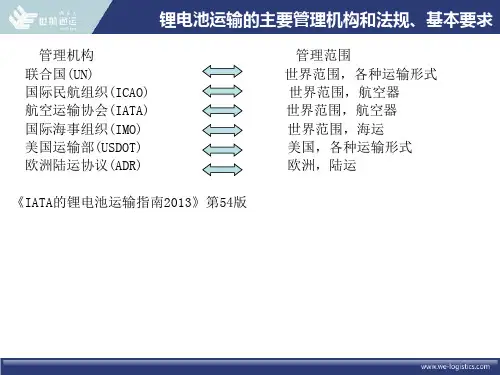
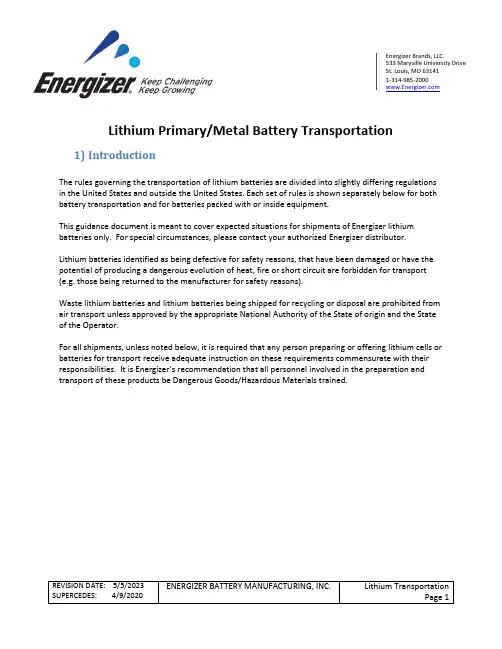
ENERGIZER BATTERY MANUFACTURING, INC.Lithium TransportationSt. Louis, MO 63141 1-314-985-2000 Lithium Primary/Metal Battery Transportation1)IntroductionThe rules governing the transportation of lithium batteries are divided into slightly differing regulations in the United States and outside the United States. Each set of rules is shown separately below for both battery transportation and for batteries packed with or inside equipment.This guidance document is meant to cover expected situations for shipments of Energizer lithium batteries only. For special circumstances, please contact your authorized Energizer distributor. Lithium batteries identified as being defective for safety reasons, that have been damaged or have the potential of producing a dangerous evolution of heat, fire or short circuit are forbidden for transport (e.g. those being returned to the manufacturer for safety reasons).Waste lithium batteries and lithium batteries being shipped for recycling or disposal are prohibited from air transport unless approved by the appropriate National Authority of the State of origin and the State of the Operator.For all shipments, unless noted below, it is required that any person preparing or offering lithium cells or batteries for transport receive adequate instruction on these requirements commensurate with their responsibilities. It is Energizer’s recommendation that all personnel involved in the preparation and transport of these products be Dangerous Goods/Hazardous Materials trained.REVISION DATE: 5/5/2023REVISION DATE: 5/5/2023 ENERGIZER BATTERY MANUFACTURING, INC.Lithium TransportationSt. Louis, MO 63141 1-314-985-2000 Table 1Label Summary Chart For Global TransportOf Lithium Batteries OnlyShipping ModeLi contentNet quantitywt. of batteries per packageBattery typeAir0.3g to <1g/cell 0.3g to <2g per battery <2.5 kg L91, L92, LA522, PhotoYES YES YES <0.3g/cell <2.5 kg All Li coin and 2L76 YES (if morethan one package in consignment)YESYES<0.3g/cell>2.5 kg All Li coin and 2L76YES YESYESLand/Sea onlyAllAllAllNOYES YES*Table 2Label Summary Chart For Global Transport Of Lithium Batteries Packed In/With EquipmentShipping ModeLi contentNet quantitywt. of batteries per packageAir All Not to exceed5kgNO YES NO Land/Sea onlyAllAllNOYESNO*Orange CAO label is only required on land/sea shipments when in the US. If the shipment is not intended for international air, it is allowable to us the "US DOT Prohibition Statement".REVISION DATE: 5/5/2023 ENERGIZER BATTERY MANUFACTURING, INC.Lithium TransportationSt. Louis, MO 63141 1-314-985-2000 Table 3Lithium Battery Shipping Label RequirementsImage NameSizeLithiumBattery Label If the package cannot accommodate a 100 X 100 mm label, the label may be sized down to 100 (width) X 70 (height) mm. Class 9 lithium 100 x 100 mmIATA Cargo Aircraft Only120 x 110 mm“PRIMARY LITHIUM BATTERIES –FORBIDDEN FOR TRANSPORT ABOARD PASSENGER AIRCRAFT” or “LITHIUM METAL BATTERIES – FORBIDDEN FOR TRANSPORT ABOARD PASSENGER AIRCRAFT”US specific “CargoAircraft Only” languageThis marking must be a background of contrasting color and the letters must be at least 6 mm in height.REVISION DATE: 5/5/2023 ENERGIZER BATTERY MANUFACTURING, INC.Lithium TransportationSt. Louis, MO 63141 1-314-985-2000 2)Requirements for all Shipments of Lithium Batteries Only – Global1.The batteries must be capable of passing the UN Model Regulation T-tests (UN Manual of Tests andCriteria, Part III, Sub-Section 38.3 Lithium Batteries).2.The shippable container must be capable of passing a 1.2 m. drop test in any orientation withoutspillage of the contents of the packaging, damage to the batteries inside or shifting of the contents that could lead to short circuit.3.The shippable container must be labeled with the labels shown in table 1 and 2.4.The net weight of the lithium cells or batteries in the shippable container shall not exceed 2.5 kg forcargo aircraft only or 30kg for surface/vessel.5.For customers re-shipping batteries, the telephone numbers (CHEMTEL phone numbers) may not beused without a subscription from CHEMTEL.3)Requirements for all Shipments of Lithium Batteries packed in/with equipment – Global1.The batteries must be capable of passing the UN Model Regulation T-tests (UN Manual of Tests andCriteria, Part III, Sub-Section 38.3 Lithium Batteries).2.For batteries packaged with equipment only, the shippable container must be capable of passing a1.2 m. drop test in any orientation without spillage of the contents of the packaging, damage to the batteries inside or shifting of the contents that could lead to short circuit.3.For batteries contained inside equipment only, the equipment must be equipped with an effectivemeans of preventing accidental activation.4.For batteries contained inside equipment only, if the package contains less than four cells or twobatteries installed within equipment, the package does not need to be labeled with the lithium battery handling label.5.The shippable container must be labeled with the labels shown in table 1 and 2.6.The net weight of the lithium cells or batteries in the shippable container shall not exceed 5 kg foraircraft.7.The CHEMTEL information is not required for batteries packaged with or in equipment, Energizeruses the same label for all shipments (batteries and batteries with or in equipment.) For customers re-shipping batteries with or in equipment, this CHEMTEL information may not be used without a subscription from CHEMTEL.St. Louis, MO 631411-314-985-20004)Within, To and From the United StatesBatteries Only – All modes (49 CFR 173.185)To ship lithium batteries by any method (rail, truck, sea vessel, air) within, to and from the United States, the shipments must meet•The labeling criteria shown in table 1 and 3•Packaging requirements listed in section 2•The US specific labeling information shown below. Note – in the US all modes of transport require this marking.The outer package that contains lithium cells or batteries must be appropriately marked with the US specific “Cargo Aircraft Only” language found in table 2 or labeled with a “CARGO AIRCRAFT ONLY” ICAO label no matter the mode of transport the shipment is offered for.Batteries Contained In/Packed With Equipment- All modes (49 CFR 173.185)To ship lithium batteries by any method (rail, truck, sea vessel, air) within, to and from the United States, the shipments must meet•The labeling criteria shown in table 2 and 3•Packaging requirements listed in section 3•The information shown below.For air shipments only:•The number of batteries in each package is limited to the minimum number required to power the piece of equipment, plus two spare sets.REVISION DATE: 5/5/2023 ENERGIZER BATTERY MANUFACTURING, INC. Lithium TransportationSt. Louis, MO 631411-314-985-20005)International (Outside the United States)Batteries Only - Air OnlyTo ship lithium batteries by air outside the US, the shipments must meet:•The labeling criteria shown in table 1 and 3•Packaging requirements listed in section 2•The specific packing instruction per IATA depending on the grams of lithium and number of cells/batteries per package.IATA Packing Instruction 968 1A for cells with lithium content in excess of 1g or batteries in excess of 2gNOTE: Energizer does not manufacture cells in excess of 1g and batteries in excess of 2g. For custom made packs that will extend above these thresholds contact your Energizer representative.IATA Packing Instruction 968 1B for lithium cells containing lithium metal no more than 1g and lithium batteries not exceeding 2g of lithium content.To ship lithium batteries by air outside the US, the shipments must meet:•The labeling criteria shown in table 1 and 3•Packaging requirements listed in section 2•The shippers declaration belowA shippers declaration is required which includes the following information:o The name and address of the shipper and consigneeo UN 3090o Lithium metal batteries, PI 968, IBo The number of packages and the gross weight of each package.REVISION DATE: 5/5/2023 ENERGIZER BATTERY MANUFACTURING, INC. Lithium TransportationREVISION DATE: 5/5/2023ENERGIZER BATTERY MANUFACTURING, INC.Lithium TransportationSt. Louis, MO 63141 1-314-985-2000 Batteries Only - Surface (Truck/Sea/Rail) IMDG/ADR RegulationsTo ship lithium batteries by rail, truck, or sea vessel outside the US, the shipments must meet:•The labeling criteria shown in table 1 and 3•Packaging requirements listed in section 2Batteries Packed With or Contained In Equipment - Air OnlyTo ship lithium batteries packed in or with equipment by air outside the US, the shipments must meet:•The labeling criteria shown in table 1 and 3•Packaging requirements listed in section 3•The specific packing instruction per IATA depending on the grams of lithium and number ofcells/batteries per package. IATA Packing Instructions 969 I and 970 I for cells with lithium content in excess of 1gor batteries in excess of 2gNOTE : Energizer does not manufacture cells in excess of 1g and batteries in excess of 2g. For custom made packs that will exceed these thresholds contact your Energizer representative.IATA Packing Instructions 969 II and 970 II for lithium cells containing lithium metal no morethan 1g and lithium batteries not exceeding 2g of lithium content.To ship lithium batteries by rail, truck, and sea vessel within, outside the United States, the shipments must meet•The labeling criteria shown in table 2 and 3•Packaging requirements listed in section 3•The information shown below.The number of batteries in each package is limited to the minimum number required to power the piece of equipment, plus two spare s ets .Batteries Packed With or Contained In Equipment - Surface (Truck/Sea/Rail) IMDG/ADR RegulationsTo ship lithium batteries by rail, truck, and sea vessel within, outside the United States, the shipments must meet•The labeling criteria shown in table 2 and 3•Packaging requirements listed in section 3。
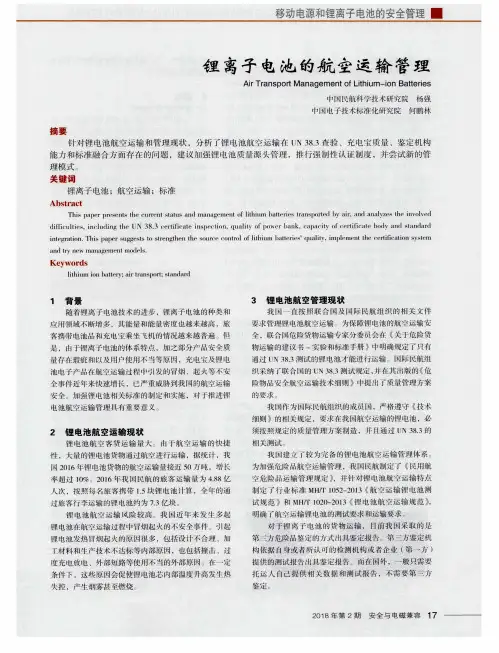
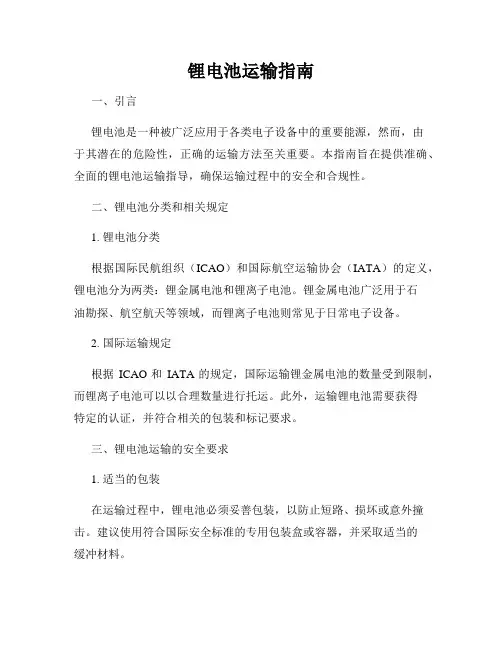
锂电池运输指南一、引言锂电池是一种被广泛应用于各类电子设备中的重要能源,然而,由于其潜在的危险性,正确的运输方法至关重要。
本指南旨在提供准确、全面的锂电池运输指导,确保运输过程中的安全和合规性。
二、锂电池分类和相关规定1. 锂电池分类根据国际民航组织(ICAO)和国际航空运输协会(IATA)的定义,锂电池分为两类:锂金属电池和锂离子电池。
锂金属电池广泛用于石油勘探、航空航天等领域,而锂离子电池则常见于日常电子设备。
2. 国际运输规定根据ICAO和IATA的规定,国际运输锂金属电池的数量受到限制,而锂离子电池可以以合理数量进行托运。
此外,运输锂电池需要获得特定的认证,并符合相关的包装和标记要求。
三、锂电池运输的安全要求1. 适当的包装在运输过程中,锂电池必须妥善包装,以防止短路、损坏或意外撞击。
建议使用符合国际安全标准的专用包装盒或容器,并采取适当的缓冲材料。
2. 分类和标记正确的分类和标记对于确保锂电池运输的安全至关重要。
根据运输的电池类型和容量,选择正确的标签、标志和类别进行标记,以便识别和管理。
3. 冷链运输对于需要低温存储的锂电池,特别是在运输过程中的长时间运输,应使用符合要求的冷藏设备,并保持适宜的温度范围,以防止电池性能受损。
四、锂电池运输的合规性检查1. 文件和认证在进行锂电池运输之前,确保合规性文件、认证和相关文件的准备齐全,包括技术文件、安全数据表、物料安全数据表和运输合同等。
2. 审查和检查在锂电池运输之前,进行必要的审查和检查,包括货物清单、包装状况、标记和标签的正确性以及声明的运输安全要求等。
五、应急响应与事故处理1. 应急响应计划建立健全的应急响应计划,对可能发生的锂电池事故进行有序的应对,包括应急联系人、事故处理程序和必要的设备和设施。
2. 事故处理在发生锂电池事故时,采取适当的措施进行处理,包括避免进一步损坏、尽快报告给有关当局,并采取必要的安全措施保护人员和环境。
六、结论本指南提供了锂电池运输的准确、全面的指导,以确保锂电池在运输过程中的安全与合规性。
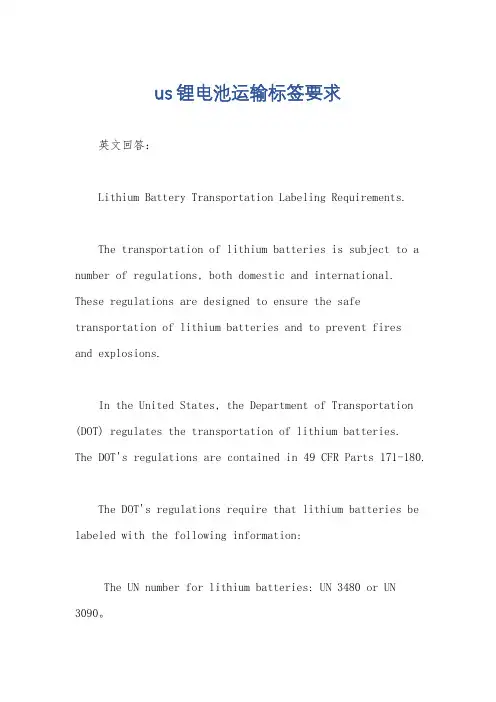
us锂电池运输标签要求英文回答:Lithium Battery Transportation Labeling Requirements.The transportation of lithium batteries is subject to a number of regulations, both domestic and international. These regulations are designed to ensure the safe transportation of lithium batteries and to prevent firesand explosions.In the United States, the Department of Transportation (DOT) regulates the transportation of lithium batteries.The DOT's regulations are contained in 49 CFR Parts 171-180.The DOT's regulations require that lithium batteries be labeled with the following information:The UN number for lithium batteries: UN 3480 or UN 3090。
The proper shipping name: Lithium batteries or Lithium batteries packed with equipment.The hazard class: Class 9。
The packing group: Group I, II, or III.The net weight of the lithium batteries in kilograms.The name of the shipper and the consignee.The address of the shipper and the consignee.The telephone number of the shipper and the consignee.The emergency response telephone number.The date of shipment.The total number of packages.In addition to the DOT's regulations, there are a number of other international regulations that apply to the transportation of lithium batteries. These regulations include the International Air Transport Association (IATA) Dangerous Goods Regulations and the International Maritime Dangerous Goods (IMDG) Code.The IATA Dangerous Goods Regulations and the IMDG Code contain similar requirements to the DOT's regulations. However, there are some minor differences between the regulations. For example, the IATA Dangerous Goods Regulations require that lithium batteries be labeled with a lithium battery mark. The IMDG Code does not require a lithium battery mark.It is important to be aware of the different regulations that apply to the transportation of lithium batteries. Failure to comply with these regulations can result in fines and other penalties.中文回答:美国锂电池运输标签要求。
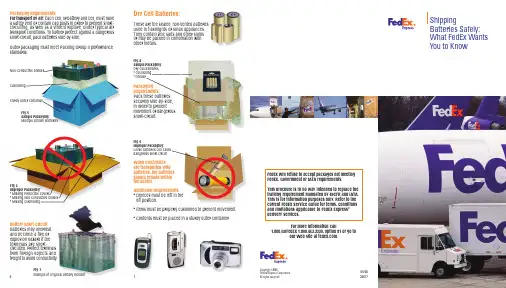
These are the sealed, non-vented batteries • Devices must be left in the • Items must be properly cushioned to prevent movement.Fig. 6Improper Packaging:• Missing Protective Covers• Missing Non-Conductive Divider • Missing CushioningExample of a typical battery incidentcircuited. Protect terminals from foreign objects and freight to avoid conductivity.Sample Packaging:Multiple Lithium BatteriesNon-Conductive DividerSturdy Outer Container7Lithium Batteries:• UN3090 lithium batteries,rechargeable and nonrechargeable.Regulations.The regulations pertaining to transporting lithium cells and batteries have changed significantly. Testing and transportation requirements are found in Title 49CFR 173.185and the UN Manual of Tests and Criteria. The U.S. Department of Transportation Pipeline and Hazardous Materials Safety Administration (DOT PHMSA), recently implemented a prohibition of primary (nonrechargeable) lithium batteries on passenger-carrying aircraft. The prohibition, which became effective on Dec. 29, 2004, was enacted based on research from incidents involving the transport of lithium batteries.While the law does not prohibit primary lithium batteries on cargo aircraft, FedEx Express has implemented additional packaging requirements on primary lithium batteries as outlined below. This policy applies to:• Lithium batteries and cells shipped fully marked, labeled and certified in accordance with the International Air Transport Association (IATA) dangerous-goods regulations.• Lithium batteries and cells shipped under "Competent Authority" granted by any national authority.• Lithium batteries and cells previously excepted from other regulatory requirements in the IATA dangerous-good regulations Special Provision A45.Packaging Requirements for Primary Lithium Batteries:• Primary lithium batteries and cells must be individually packaged in fully enclosed inner packaging consisting of plastic blister wrap, pasteboard or other fully enclosed packaging that will protect each battery and cell from making contact with another lithium battery or cell, or any item that is capable of conducting electricity, in order to prevent short-circuiting. Please note: Multiple batteries enclosed in a single form-fitting "retail ready" blister pack are acceptable.• Shippers are required to contact FedEx Express Dangerous Goods Administration and certify that they comply with this lithium battery and cell standard.• We will accept shipments of primary lithium batteries and cells offered as "excepted" or nonregulated per the IATAdangerous-goods regulations with preapproval from FedExWet Batteries:• UN2794 batteries wet filled withacid, electric storage.• UN2795 batteries wet filled with alkali, electric storage.Packaging Requirements:Outer packaging must be UN Specification Packaging, as pictured in Fig. 1 on page 2. These containers must incorporate an acid/alkali leak-proof liner adequately sealed to prevent leakage in the event of a spill.Securely fasten the batteries with the fill openings and vents facing upward. This will prevent short-circuiting.Check the orientation labels on the outside of the packaging to determine the upright position: the words “This End Up”or “This Side Up” may be displayed on top of the package.Packaging Requirements:Securely pack in strong outer packaging. Be sure to protect against short-circuiting by positioning batteries side-by-side.ContainerFig. 2Fig. 1UN SPECIFICATION PACKAGINGAll metal containers must incorporate an acid/alkali leak-proof liner adequately sealed to prevent leakage in the event of a spill.234Express Dangerous Goods Administration. Contact FedEx Express Dangerous Goods Administration or your FedEx account executive for complete details and procedures.• FedEx Express Dangerous Goods Administration will maintain an internal list of approved shippers. Shippers cannot continue to ship primary lithium batteries unless they are on the approved shipper list. Contact FedEx Express Dangerous Goods Administration or your FedEx account executive for details on how to be placed on the list.• The above requirements are in addition to the IATA dangerous-goods regulations and any other packaging or shipping requirements.For more information and procedures on shipping primary lithium batteries, see Lithium Batteries UN 3090 Under IATA Special Provision A45 or Lithium Batteries UN 3090Nonspillable Batteries:In accordance with 49CFR 173.159 and USG-11, anonspillable wet electric storage battery may be regarded as not subject to the Regulations if the battery and its outer packaging are plainly and durably marked ”NONSPILLABLE“ or”NONSPILLABLE BATTERY“ and the battery meets the conditions for being regarded as not subject to the Regulations as prescribed in SpecialProvision A67 (No shipper’s declaration required).Transporting Batteries by Air.At FedEx,we understand the importance of ensuring the safe transport of batteries throughout our system.Charged batteries may short-circuit and cause a fire and some batteries contain corrosive liquid.Therefore, if proper packaging requirements are not met, these shipments may cause a variety of problems during transport. FedEx is providing this information guide to assist you in safely packaging batteries for shipment.5A45 Special Provision Package UN Specification Packaging。
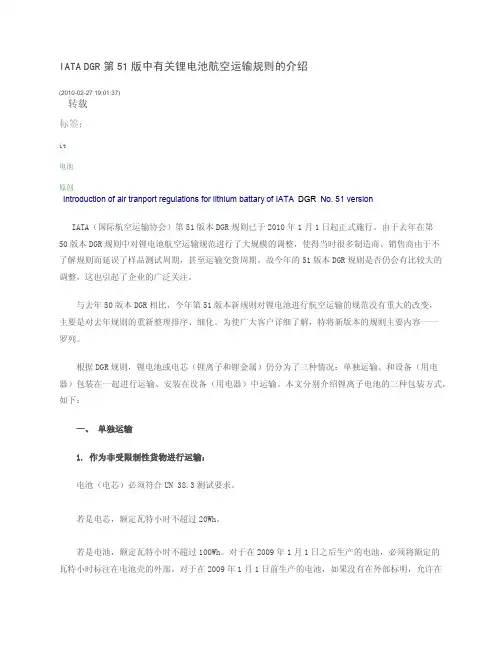
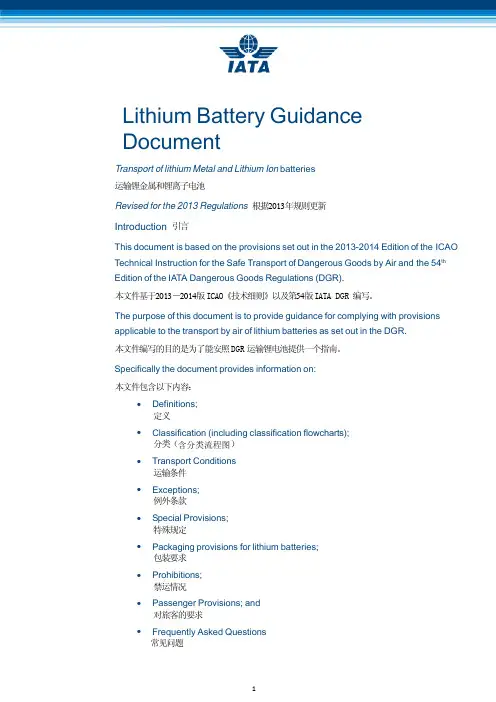
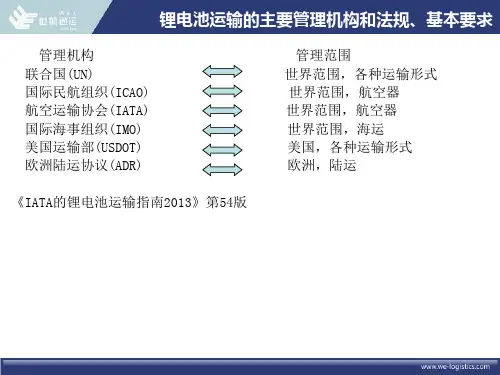
关于锂电池Section II空运随附声明运单号:警告:因为安全隐患原因而被厂家召回的锂电池禁止空运本包装件内含有如下所列的锂电池或电池芯(检查是否使用),电池/芯已通过了联合国《危险品运输建议-实验与标准手册》第38.3章节测试,该锂电池的生产符合了IA TA 《危险品规则》3.9.2.6(e)中规定的质量管理程序。
被测试的包装件能够承受1.2米跌落试验(除PI967和PI970外)锂离子电池.●每个电池芯能量不超过20瓦时;且●每个电池芯能量不超过100瓦时锂金属电池 .●每个电池芯含量不超过1克;且●每个电池锂含量不超过2克纯运输电池或电池芯(ICAO/IA TA 包装说明965,Section II)—包装件内只有电池或电池芯,没有设备。
包装件限量:≤2.7Wh=2.5kg;或>2.7Wh bu t ≤20Wh=8 电池芯;或>2.7Wh but ≤100Wh=2 电池纯运输电池或电池芯(ICAO/IATA包装说明968,Section II)—包装件内只有电池或电池芯,没有设备。
包装件限量:≤0.3g=2.5kg;或>0.3 g but ≤ 1 g=8 电池芯;或>0.3 g but ≤ 2 g=2 电池纯运输电池或电池芯(ICAO/IA TA包装说明965,Section IB)—包装件内只有电池或电池芯,没有设备。
纯运输电池或电池芯(ICAO/IA TA 包装说明968,Section IB)—包装件内只有电池或电池芯,没有设备。
和设备包装在一起(ICAO/IA TA 包装说明966,Section II)—电池或电池芯作为附件和电子设备包装在一个包装件内和设备包装在一起(ICAO/IATA包装说明969,Section II)—电池或电池芯作为附件和电子设备包装在一个包装件内,该设备由电池驱动,且电池没有安装在设备内。
安装在设备中(ICAO/IA TA 包装说明967,Section II)—电池或电池芯安装在设备中安装在设备中(ICAO/IA TA 包装说明970,Section II)—电池或电池芯安装在设备中●应小心操作,如包装破损,有易燃危险性:●如该包装件在运输中破损,在未确定内部物品状态前不能装载。
Transport of Lithium Batteries in Accordance withthe ICAO Technical InstructionsGuidance DocumentForewordThe 2009-2010 ICAO Technical Instructions for the Safe Transport of Dangerous Goods by Air incorporated a number of revisions to requirements for the transport of lithium batteries. Revisions included:• Development of new Packing Instructions 965, 966, 967, 968, 969 and 970 to more clearly state requirements for the various types of lithium batteries.• Incorporation of the requirements formerly in Special Provision A45 within the new packing instructions.• Application of a new lithium battery handling label for certain lithium batteries.• Enhanced packaging and revised quantity limits for lithium batteries as shown in Table 3-1 and in the new Packing Instructions.This guidance is intended to address commonly asked questions regarding these provisions. In an effort to continually improve this guidance, comments or additional questions are welcome and will be used to update the guidance periodically. Comments may be submitted at:www.icao.int/anb/FLS/DangerousGoods/ICAOLithiumBatteryGuidance.The guidance is divided into several parts as follows:Part 1 – Questions Related to DefinitionsPart 2 – Questions Related to Transport ProvisionsPart 3 – Questions Related to Design Type Testing ProvisionsPart 4 – Questions Related to State and Operator VariationsThis guidance addresses only the baseline provisions of the ICAO Technical Instructions. The ICAO Technical Instructions also contain State and Operator variations which should be consulted to determine any additional requirements imposed by a particular State or Operator (see Attachment 3 of the ICAO Technical Instructions – “Notified Variations from the Instructions”).Part 1 – Questions Related to DefinitionsA. What are the various types of lithium batteries?Lithium batteries fall into two broad classifications; lithium metal batteries and lithium ion batteries. Lithium metal batteries are generally non-rechargeable and contain metallic lithium. Lithium ion batteries do not contain metallic lithium and are rechargeable.B. What are lithium polymer batteries?A lithium polymer battery is a type of lithium ion battery. Generally, the main difference is lithium ion polymer batteries contain a polymer electrolyte.C. What is the difference between a lithium cell and a lithium battery?A lithium cell is a single encased electrochemical unit consisting of one positive and one negative electrode that exhibits a voltage differential across the two terminals. A lithium battery is one or more cells electrically connected. A single cell battery is considered a cell and not a battery.D. How are component cells connected to form a battery?Cells in batteries may be connected in parallel, in series, or in a combination of the two. When cells are connected in series the voltage of the battery increases but the capacity in ampere-hours (Ah) does not change. By contrast, when cells are connected in parallel the capacity in ampere-hours of the battery (Ah) increases but the voltage stays the same.E. How do I determine the watt hour rating for a particular lithium ion battery?The watt hour (Wh) rating is a measure by which lithium ion batteries are regulated. Lithium ion batteries manufactured after 1 January 2009 are required to be marked with the watt hour rating.You can also arrive at the number of watt-hours your battery provides if you know the battery’s nominal voltage (V) and capacity in ampere-hours (Ah):Ah x V = WhThis information is often marked on the battery.Note that if only the milli-ampere-hours (mAh) are marked on the battery then divide that number by 1000 to get ampere-hours (Ah) (i.e., 4400 mAh / 1000 = 4.4. Ah).Most lithium ion batteries marketed to consumers are below 100 watt-hours. If you are unsure of the watt-hour rating of your lithium ion battery, contact the manufacturer.Part 2 – Questions related to Packaging and Transport ProvisionsA. How do I safely package lithium batteries for transport?One of the major risks associated with the transport of batteries and battery-powered equipment is short-circuit of the battery as a result of the battery terminals coming into contact with other batteries, metal objects, or conductive surfaces. Packaged batteries or cells must be separated in a way to prevent short circuits and damage to terminals. They must be packed in a strong outer packaging or be contained in equipment. Sample packaging meeting these requirements is shown below:B. How can batteries be effectively protected against short circuit?Methods to protect against short circuit include, but are not limited to, the following methods:a) Packing each battery or each battery-powered device when practicable, in fullyenclosed inner packagings made of non-conductive material (such as a plastic bag);b) Separating or packing batteries in a manner to prevent contact with otherbatteries, devices or conductive materials (e.g., metal) in the packagings; andc) Ensuring exposed terminals or connectors are protected with non-conductive caps,non-conductive tape, or by other appropriate means.If not impact resistant, the outer packaging should not be used as the sole means of protecting the battery terminals from damage or short circuiting. Batteries should besecurely cushioned and packed to prevent shifting which could loosen terminal caps or reorient the terminals to produce short circuits.Terminal protection methods include but are not limited to the following:a) Securely attaching covers of sufficient strength to protect the terminals;b) Packaging the battery in a rigid plastic packaging; andc) Constructing the battery with terminals that are recessed or otherwise protected sothat the terminals will not be subjected to damage if the package is dropped.C. What does the new lithium battery handling label look like and when is itrequired?The new lithium battery handling label is required as specified in the additional requirements of Section II of packing instructions 965, 966, 967, 968, 969 and 970. The new label is as shown in Figure 5-31 of Part 5 of the ICAO Technical Instructions. The border of the label must have red diagonal hatchings with text and symbols in black on a contrasting background. The lithium battery handling label may be printed directly on the outer packaging provided that there is sufficient contrast between the elements of the lithium battery label and the colour of the packaging material.110 mm* Place for “Lithium ion battery” and/or “Lithium metal battery”D. When is a lithium battery handling label not required?A lithium battery handling label is not required for packages prepared in accordance with Section I of Packing Instructions 965-970 (i.e. bearing a Class 9 label) or when a package contains no more than 4 cells or 2 batteries installed in equipment prepared in accordance with Section II of Packing Instructions 967 and 970. This applies to UN 3481 Lithium ion batteries contained in equipment (See Section II of Packing Instruction 967) and UN3091 Lithium metal batteries contained in equipment (see section II of Packing Instruction 970). As these packages do not require a lithium battery handling label, the accompanying document mentioned in the Additional Packing Requirements of Section II of Packing Instructions 967 and 970 are not required.E. Is there a requirement for the Lithium Battery Handing Label to be available inlanguages other than English?English is generally the standard language accepted in international aviation. However, the State of Origin where offering the package for shipment may require their official language. Part 5;2.5 of the ICAO TI specifies that in addition to the languages which may be required by the State of Origin, English should be used.F. For the purposes of the lithium battery packing instructions, what is consideredthe "package"?The package is the complete product of the packing operation that satisfies the requirement of the packing instruction. The package may contain multiple batteries or pieces of equipment provided the limitations set out in the Packing Instruction are not exceeded. The package must be marked and labelled as required by the Packing Instruction. A single package may be offered for transport, or one or more packages may then be placed into an overpack for ease of handling or transport purposes. When an overpack is used, the package markings and labels must be duplicated on the overpack unless the markings and labels required on individual packages are visible, or are not required by the Packing Instruction (i.e. less than 4 cells or 2 batteries when contained in equipment).G. Please explain the documentation requirements for consignments of lithiumbatteries.Each consignment of packages with lithium batteries that is required to have the lithium battery handling label must be accompanied by a document such as an airway bill or other document that indicates:• The package contains lithium ion cells or batteries;• The package must be handled with care and that a flammability hazard exists if the package is damaged;• Special procedures should be followed in the event the package is damaged, to include inspection and repacking if necessary; and• A telephone number for additional information.This document may be in any form provided it contains all the appropriate information and accompanies the consignment. For example, the document may be provided separately to the carrier or in a pouch attached to the package.H. Does ICAO require an MSDS containing the UN test data?No. ICAO does not require the use of MSDS and test data is not part of the required documentation requirements when offering lithium batteries for transport.I. Section II in Packing Instructions 967 and 970 states that "Each packagecontaining more than four cells or more than two batteries installed in equipment must be labelled with a lithium battery handling label." What is the intent of this provision?This provision authorizes packages with equipment containing no more than 2 batteries or 4 cells to be offered for transport without the lithium battery handling label. For example, a package containing a notebook computer may have 1 lithium ion battery and 2 small lithium metal coin cells installed in the product. This single package does not require the lithium battery handling label. The number of cells contained inside the lithium ion battery are NOT counted towards the 4 cell limitation because it is the battery installed in the equipment being presented for transport. In addition, multiple packages each containing no more than 2 batteries or 4 cells may be overpacked and neither the individual packages nor the overpack would require the label.J. I have an MP3 player that contains one single-cell lithium ion battery pack. Do I have to label the shipping box that contains each MP3 player? What if I place five MP3 players in a shipping box? Does this require a label?For packages of single MP3 players, no lithium battery label would be required since you can place up to 4 of these single-cell batteries in a box without labelling the outer box. In the case where 5 MP3 players are in a shipping package, a lithium battery label on the outer shipping package would be required.K. Under Packing Instructions 966 and 969, it states that “The maximum number of batteries in each package must be the minimum number required to power the equipment, plus two spares”. If a package contains 4 power tools (each tool contains a lithium ion battery), can 2 extra lithium ion batteries be placed in the package for each piece of equipment for a total of 8 batteries?Yes. The 8 batteries reflect two spares for each of the 4 power tools in the outer package. L. Can a single label be used to identify that both lithium metal and lithium ion batteries are contained inside the package?Yes. A single label identifying both lithium ion and lithium metal batteries may be used.M. May lithium battery packages be placed in an overpack in accordance with the new ICAO Technical Instructions?Yes. The overpack may also contain packages of dangerous goods or goods not subject to these Instructions provided there are no packages enclosing different substances which might react dangerously with each other. An overpack must be labelled with the lithium battery label (Figure 5-31) of the ICAO Technical Instructions unless the label(s) on the package(s) inside the overpack are visible. In addition, the word “overpack” must be marked on overpacks containing packages transported in accordance with Section I of the applicable Packing Instructions (i.e. bearing Class 9 labels).N. Do the quantity limits shown in the ICAO packing instructions apply to overpacks containing lithium batteries?The quantity limits shown in packing instructions 965 and 968, refer to the package. Provided each package remains under the limit specified in the packing instruction, the overpack may exceed the specified limits.O. Packing Instructions 966 and 969 Section II include a requirement for a 1.2 meter drop test. What portion or portions of the package are subject to this test? The completed package containing batteries as prepared for transport in accordance with the relevant packing instruction must be capable of withstanding the 1.2 meter drop test. This could apply to a package solely containing batteries that is packaged in full compliance with the provisions of the packing instruction (to include the 1.2 meter drop test capability requirement) and is then overpacked with equipment and offered for transport (see item 2M for additional information related to overpacks). Or, it could apply to a package that includes batteries properly packed in inner packaging and equipment or other non-dangerous goods that are placed in a single outer packaging. The package that includes both the inner packaging containing batteries and the equipment must comply with the packing instruction to include meeting the capability to pass the 1.2 meter drop test.P. How do I transport prototype lithium cells and batteries that have not been UN Tested?Prototype lithium batteries may be transported by cargo aircraft if you do the following:1.Obtain approval by the competent authority of the origin country prior totransport;2.Place no more than 12 batteries or 24 cells in a package;3.Protect the cells and batteries from short circuiting;4.Pack each of the cells or batteries in an inner packaging inside an outer packagingthat completely surrounds the cells and batteries. All packaging and cushioning material must be non-conductive and non-combustible5.Place the cells and batteries in an outer drum or box made of metal, plastic orplywood that meets Packing Group I performance requirements.Q. Can I ship recalled, damaged or non-conforming cells or batteries?Lithium batteries, identified by the manufacturer as being defective for safety reasons, orthat have been damaged, that have the potential of producing a dangerous evolution of heat, fire or short circuit are forbidden for transport (e.g. those being returned to the manufacturer for safety reasons). The U.S. DOT has developed guidance for consumersand manufacturers for shipping recalled batteries. /Battery_Recall_Guidance.pdfBatteries which have some other defective feature (e.g., LEDs not showing charge, incorrect model number on label, or batteries not holding enough charge) could still be shipped by air. Also, laptops being returned may not have a defective battery, it may notmeet the needs of the customer, may be defective itself (but not the battery), etc. In these situations air transport would be permitted. The battery or equipment manufacturer should be contacted to determine the appropriate shipping method.R. What are the requirements for the telephone number on the lithium battery handling label?The telephone number should be of a person knowledgeable about the shipment but is not intended to be for the purposes of obtaining immediate emergency response guidance,and is therefore not required to be monitored at all times that the package is in transit. Itis acceptable for the number to be monitored during the company’s normal business hours in order to provide product-specific information relative to the shipment. However,it also is acceptable to use an emergency response, 24-hour phone number on the label.S. How do I protect against “inadvertant activation”?When batteries are contained in equipment, the equipment should be packaged in a manner that prevents unintentional activation or should have an independent means of preventing unintentional activation (e.g., packaging restricts access to activation switch, switch caps or locks, recessed switches, trigger locks, temperature sensitive circuit breakers, etc.). This requirement does not apply to devices which are intentionally activein transport (RFID transmitters, watches, sensors etc.) and which are not capable of generating a quantity of heat sufficient to be dangerous to packaging or personal safety.Part 3 – Questions Related to Design Type Testing ProvisionsA. Where can I find requirements related to testing of battery design types?The UN Manual of Tests and Criteria sets out specific tests that must be conducted oneach lithium cell or battery design type. Each test is intended to either simulate a common transportation occurrence such as vibration or changes in altitude or to test the integrity ofa cell or battery. You may obtain a copy of these testing requirements via the following website: /trans/danger/publi/manual/manual_e.html.B. What constitutes a design change requiring renewed design type testing?A cell or battery that differs from a tested design by more than 0.1 grams or 20 % to the anode, cathode or electrolyte is considered to be a design change. A change that would materially affect the test results is also a design change.Examples of design changes may include the use of a different type of cathode materialor a change in the battery’s geometry.Part 4 – Questions Related to State and Operator VariationsA. What additional requirements are imposed by US Variation 2?The United States restricts the transport of certain primary (non-rechargeable) lithium metal batteries, both packaged batteries and those packed with our contained in equipment, from transport on passenger carrying aircraft. In accordance with US Variation 2, primary (non-rechargeable) lithium metal batteries and cells (UN3090) are forbidden for transportation aboard passenger-carrying aircraft. Such batteries transported in accordance with Section I of Packing Instruction 968 must be labelled with the cargo aircraft only label. Such batteries transported in accordance with Section II of Packing Instruction 968 must be marked “PRIMARY LITHIUM BATTERIES — FORBIDDEN FOR TRANSPORT ABOARD PASSENGER AIRCRAFT” or “LITHIUM METAL BATTERIES — FORBIDDEN FOR TRANSPORT ABOARD PASSENGER AIRCRAFT”.Primary (non-rechargeable) lithium metal batteries and cells contained in or packed with equipment (UN3091) are forbidden for transportation aboard passenger-carrying aircraft unless:1) The equipment and the batteries and cells are transported in accordance withPacking Instruction 969 or 970, as appropriate;2) The package contains no more than the number of lithium metal batteries or cellsnecessary to power the intended piece of equipment;3) The lithium content of each cell, when fully charged, is not more than 5 grams;4) The aggregate lithium content of the anode of each battery, when fully charged, isnot more than 25 grams; and5) The net weight of lithium batteries does not exceed 5 kg (11 pounds).Primary (non-rechargeable) lithium metal batteries and cells contained in or packed with equipment (UN3091) and transported in accordance with Section I of Packaging Instruction 969 or 970 that do not conform to the above provisions are forbidden for transportation aboard passenger carrying aircraft and must be labelled with the cargo aircraft only label.Primary (non-rechargeable) lithium metal batteries and cells contained in or packed with equipment (UN3091) and transported in accordance with Section II of Packaging Instruction 969 or 970 that do not conform to the above provisions are forbidden for transportation aboard passenger carrying aircraft and must be marked “PRIMARY LITHIUM BATTERIES — FORBIDDEN FOR TRANSPORT ABOARD PASSENGER AIRCRAFT” or “LITHIUM METAL BATTERIES — FORBIDDEN FOR TRANSPORT ABOARD PASSENGER AIRCRAFT”.— — — — — — — —ATTACHMENTLITHIUM BATTERY PACKING INSTRUCTIONSPACKING INSTRUCTION 965+Passenger and cargo aircraft for UN 3480This entry applies to lithium ion or lithium polymer batteries in Class 9 (Section I) and lithium ion or lithium polymer batteries subject to specific requirements of these Instructions (Section II).SECTION ISection I requirements apply to each cell or battery type that has been determined to meet the criteria for assignment to Class 9.Each cell or battery must:1) be of the type proven to meet the requirements of each test in the UN Manual of Tests and Criteria,Part III, section 38.3; and2) incorporate a safety venting device or be designed to preclude a violent rupture under conditionsnormally incident to transport and be equipped with an effective means of preventing external shortcircuits.Each battery containing cells or a series of cells connected in parallel must be equipped with an effective means, as necessary, to prevent dangerous reverse current flow (e.g. diodes, fuses).General requirementsPart 4;1 requirements must be met.Package quantity (Section I)Contents Passenger CargoLithium ion cells and batteries 5 kg G 35 kg GADDITIONAL PACKING REQUIREMENTS— Lithium ion cells and batteries must be protected against short circuits.— Packagings must meet the Packing Group II performance requirements.— Lithium ion batteries with a mass of 12 kg or greater and having a strong, impact-resistant outer casing, or assemblies of such batteries, may be transported when packed in strong outer packagings and protective enclosures not subject to the requirements of Part 6 of these Instructions, if approved by the appropriate authority of the State of Origin. A copy of the document of approval must accompany the consignment.OUTER PACKAGINGSBoxes Drums JerricansAluminium (4B) Aluminium (1B2) Aluminium (3B2)Fibreboard (4G) Fibre (1G) Plastic (3H2)Natural wood (4C1, 4C2) Plastic (1H2) Steel (3A2)Plastic (4H2) Plywood (1D)Plywood (4D) Steel (1A2)Reconstituted wood (4F)Steel (4A)SECTION IILithium ion cells and batteries offered for transport are not subject to other additional requirements of these Instructions if they meet the requirements of this section.Lithium batteries, identified by the manufacturer as being defective for safety reasons, or that have been damaged, that have the potential of producing a dangerous evolution of heat, fire or short circuit are forbidden for transport(e.g. those being returned to the manufacturer for safety reasons).Lithium ion cells and batteries may be offered for transport if they meet the following:1) for lithium ion cells, the Watt-hour rating (see Attachment 2) is not more than 20 Wh;2) for lithium ion batteries, the Watt-hour rating is not more than 100 Wh;— the Watt-hour rating must be marked on the outside of the battery case except for those batteries manufactured before 1 January 2009, which may be transported in accordance with the provisions ofthis section and without the marking until 31 December 2010;3) each cell or battery is of the type proven to meet the requirements of each test in the UN Manual of Testsand Criteria, Part III, section 38.3.General requirementsBatteries must be packed in strong outer packagings that conform to Part 4;1.1.1, 1.1.3.1 and 1.1.9 (except 1.1.9.1).Package quantity(Section II)Contents Passenger CargoLithium ion cells and batteries 10 kg G 10 kg GADDITIONAL PACKING REQUIREMENTS— Cells and batteries must be packed in inner packagings that completely enclose the cell or battery.— Cells and batteries must be protected so as to prevent short circuits. This includes protection against contact with conductive materials within the same packaging that could lead to a short circuit.— Each package must be capable of withstanding a 1.2 m drop test in any orientation without:— damage to cells or batteries contained therein;— shifting of the contents so as to allow battery to battery (or cell to cell) contact;— release of contents.— Each package must be labelled with a lithium battery handling label (Figure 5-31).— Each consignment must be accompanied with a document such as an air waybill with an indication that: — the package contains lithium ion cells or batteries;— the package must be handled with care and that a flammability hazard exists if the package is damaged;— special procedures should be followed in the event the package is damaged, to include inspection and repacking if necessary; and— a telephone number for additional information.— Any person preparing or offering cells or batteries for transport must receive adequate instruction on these requirements commensurate with their responsibilities.OUTER PACKAGINGSBoxes Drums JerricansStrong outer packagings+PACKING INSTRUCTION 966Passenger and cargo aircraft for UN 3481 (packed with equipment) onlyThis entry applies to lithium ion or lithium polymer batteries packed with equipment in Class 9 (Section I) and lithium ion or lithium polymer batteries packed with equipment subject to specific requirements of these Instructions (Section II).SECTION ISection I requirements apply to each cell or battery type that has been determined to meet the criteria for assignment to Class 9.Each cell or battery must:1) be of the type proven to meet the requirements of each test in the UN Manual of Tests and Criteria,Part III, section 38.3; and2) incorporate a safety venting device or be designed to preclude a violent rupture under conditionsnormally incident to transport and be equipped with an effective means of preventing external shortcircuits.Each battery containing cells or a series of cells connected in parallel must be equipped with an effective means, as necessary, to prevent dangerous reverse current flow (e.g. diodes, fuses).General requirementsPart 4;1 requirements must be met.Package quantity(Section I)Contents Passenger CargoQuantity of lithium ion cells andbatteries per overpack, excluding5 kg 35 kgequipmentADDITIONAL PACKING REQUIREMENTS— Lithium ion cells and batteries must be protected against short circuits.— The completed package for the cells or batteries must meet the Packing Group II performance requirements. — The equipment and the packages of lithium cells or batteries must be placed in an overpack. The overpack must bear applicable marks and labels as set out in Part 5;1 and 5;2.4.10.— For the purpose of this packing instruction, “equipment” means apparatus requiring the lithium ion batteries with which it is packed for its operation.OUTER PACKAGINGSBoxes Drums JerricansAluminium (4B) Aluminium (1B2) Aluminium (3B2)Fibreboard (4G) Fibre (1G) Plastic (3H2)Natural wood (4C1, 4C2) Plastic (1H2) Steel (3A2)Plastic (4H2) Plywood (1D)Plywood (4D) Steel (1A2)Reconstituted wood (4F)Steel (4A)SECTION IILithium ion cells and batteries (including lithium polymer) packed with equipment offered for transport are not subject to other additional requirements of these Instructions if they meet the requirements of this section.Lithium batteries, identified by the manufacturer as being defective for safety reasons, or that have been damaged, that have the potential of producing a dangerous evolution of heat, fire or short circuit are forbidden for transport (e.g. those being returned to the manufacturer for safety reasons).Lithium ion cells and batteries may be offered for transport if they meet the following:1) for lithium ion cells, the Watt-hour rating (see Attachment 2) is not more than 20 Wh;2) for lithium ion batteries, the Watt-hour rating is not more than 100 Wh;— the Watt-hour rating must be marked on the outside of the battery case except for those batteries manufactured before 1 January 2009, which may be transported in accordance with the provisions ofthis section and without the marking until 31 December 2010;3) each cell or battery is of the type proven to meet the requirements of each test in the UN Manual of Testsand Criteria, Part III, section 38.3.General requirementsBatteries must be packed in strong outer packagings that conform to Part 4;1.1.1, 1.1.3.1 and 1.1.9 (except 1.1.9.1).ADDITIONAL PACKING REQUIREMENTS— Cells and batteries must be packed in inner packagings that completely enclose the cell or battery.— Cells and batteries must be protected so as to prevent short circuits. This includes protection against contact with conductive materials within the same packaging that could lead to a short circuit.— The maximum number of batteries in each package must be the minimum number required to power the equipment, plus two spares.— Each package must be capable of withstanding a 1.2 m drop test in any orientation without: — damage to cells or batteries contained therein;— shifting of the contents so as to allow battery to battery (or cell to cell) contact;— release of contents.— Each package must be labelled with a lithium battery handling label (Figure 5-31).— Each consignment must be accompanied with a document such as an air waybill with an indication that: — the package contains lithium ion cells or batteries;。